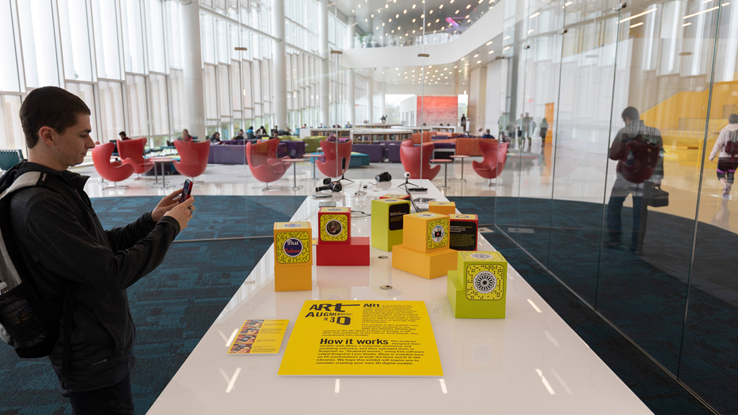
3D “ARt” exhibit opens at Hunt Library

Sometimes the art isn’t actually there.
“ARt: Augmented Reality in 3D” is an AR exhibit—accessed via Snapchat—in the Hunt Library's Technology Showcase. Students in College of Design professor Emil Polyak’s Digital Modeling course (ADN 423) created virtual models that you can view through your cell phone. Polyak also contributed two models, as did the Libraries’ Digital Research and Scholarship Librarian Markus Wust. The exhibit will run into summer 2018.
To view “ARt,” open the Snapchat mobile app on your phone, point the phone at the colorful image, or target, in the Technology Showcase, and take a picture of it. After a few moments, the 3D digital model will pop up inside the app. You can then select the model to view in augmented reality.
Augmented reality mixes virtual content with the real world, often with digital images added to a person’s view of reality through a phone camera, as in the Pokemon Go! Game, or through a high-tech headset such as Microsoft’s HoloLens.
“AR is a unique intersection of what is real and what is virtual,” Polyak says. “It is always fascinating to see something and believe as if it was there while it actually doesn't even exist. It really reminds us of the ‘Pepper's Ghost’ technique that was popular in nineteenth-century theater, superimposing a reflection of a person on a sheet of glass on the stage. To create a virtual exhibition in a physical space I think turns the objects into more precious pieces by exposing them in a real ‘sacred’ location.”
Polyak’s students used a computer animation and modeling software called Maya (available on PC workstations at the Libraries) to design their models. Then, they uploaded them to Snapchat as “Snapchat lenses” using free software called Snapchat Lens Studio.
The eight models in the exhibit include “Trash Bandit” by Emily Parker (Senior, Art and Design), a comical take on the nickname given to raccoons; “Islamic Lantern” by Rakan DiarBakerli (Graduate student, Art and Design Animation), which features an ornate take on traditional Islamic geometric designs; Polyak’s “Monkey King,” which digitally reconstructs a traditional Taiwanese hand puppet of a Chinese mythological character; and Wust’s “First Walkman,” which pays homage to the popular personal stereo audio cassette player.